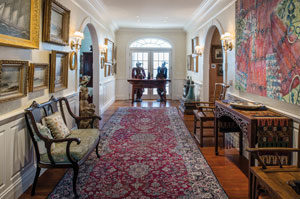Summerguide 2017 | view this story as a .pdf
“There is a thing inherent and natural, which existed before heaven and earth, motionless and fathomless…” –Laozi
By Colin W. Sargent
 Screened by trees along Shore Road in Cape Elizabeth, many shingled mansions harbor dazzling views and riveting stories. But what lies behind the army of stone Chinese Zodiak creatures guarding the entrance to No. 1172? Welcome inside the palace that’s for sale for $11M.
Screened by trees along Shore Road in Cape Elizabeth, many shingled mansions harbor dazzling views and riveting stories. But what lies behind the army of stone Chinese Zodiak creatures guarding the entrance to No. 1172? Welcome inside the palace that’s for sale for $11M.
Here’s a clue. It’s owned by a native Mainer, the founder of the second-largest environmental law firm in the United States.
Here’s another clue. It has two grand pianos.
Have you guessed yet? The seller is former Maine gubernatorial candidate Eliot Cutler, who was “fox-bewitched” by this neck of the woods in the late 1990s and commissioned Wright-Ryan Construction to build this stunning mansion, hidden from view but alive with perspective in a setting where moving spirits seem to sweep across the sea.
In fact, a great deal of the spirit of this retreat springs from the three years (2006-2009) Cutler spent in China. From garden sculptures to China Trade antiques, the 15,000-square-foot enclave blends the Maine mystique with the Far East. On the yang side, this house brings out the Wyeth in you, rugged and sure. On the yin side, it brings out the Laozi in you–deceptively playful. Beyond the “four-bedroom guest house, pool, tennis court…and 600 feet of bold Atlantic frontage” in the brochure, there’s an elegant sense of detachment here, yet a visitor feels intimately connected to the symphony of rocks, beach, and sea.
Cutler, educated at Deerfield Academy, Harvard, and Georgetown Law, seems to enjoy channeling the spirit of his surroundings. “I grew up in Bangor and on Hancock Point on Frenchman’s Bay,” he says. “It took two years to find this property. Once we saw it and bought it, we wanted to build a house that sat well on the land and was not overly imposing from the road or water.” One more thing: “We needed lots of room for us and our family, a growing family along the course of time, where we could gather family and friends to enjoy the Maine coast with us.” It was just then that “I’d merged my law firm with a big international firm. A condition was that I could commute from Maine, and we did it. I did it.”
To design this house deliberately imagined without a name, “We interviewed 10 architects. We chose Bob Knight of Blue Hill,” Cutler says. “I’m not one to give names to houses. We view this as a home, not as some kind of estate. We had 50 brokers in yesterday, looking at the house. Several remarked at how cozy it was, regardless of how large. That was a major objective of ours.”
As cozy as this home may be, most retreats don’t have a library on the scale of Cutler’s, extending across two dimensions. “The libraries are two levels,” nearly windowless but for clerestories, connected by a spiral stair. “It’s the main turret.” Asked if some lucky books from his childhood home floated into his new library, he’s enthusiastic. “The multi-volume Winston Churchill History of World War II.” Yup, we’re talking with Eliot Cutler. “All the Robert McCloskey Books.” One Morning in Maine meets One Morning in Beijing.
“My favorite part of the library is the fireplace. Growing up on Grove Street in Bangor, I loved the fireplace and the large mantel around it in our house. At first, I wanted to take the mantel and fireplace and put it here.” Then he reconsidered. “I asked Bob Knight if he could duplicate it, and he did. He took extremely careful measurements.” To complete the illusion of stopped time, “I brought two lamps from the mantel” in Bangor. They’d always hovered over the fireplace. “Now it really feels like the fireplace where I grew up, but it’s here.
“Another strong echo in the house comes from the three years when I lived in Beijing, when we acquired a lot of Chinese vernacular furniture, including two wedding beds.” Which may be the answer to: What do you give a man who has two pianos?
“All our furniture from China is here,” including large artworks such as Chinese Zodiac stoneware. “We brought it back in 2009 by container.” But what to bring? “We had some very heavy Chinese outside lanterns, tables, and stools, all made of stone and cement. We thought that shipping them back would be prohibitively expensive. But when you’re shipping a container, you’re shipping by volume, not by weight.”
Only a third of the container was full. “So we went to the Dirt Market in Beijing, and we bought an enormous amount of stone and cement” sculpture. “It’s all here and gives character to the house and the land.”
Of course, in Maine, you don’t need to travel to China to purchase China Trade antiques. Maine sailing ships brought such treasures to our shores under the creak of oak and canvas.
“Exactly right. I have several pieces of old Chinese stuff, including a huge ivory ship and some cloisonne. These are articles I bought at Jim Julia’s auctions even before I ever thought of going to China. There’s a lot of old China here from ships in the China Trade.”
Since we’re here for the tour, tell us about the kitchen.
“There were two cabinetmakers. One was Wright Ryan. They have their own cabinetry shop. A local Cape Elizabeth cabinetry guy did an enormous amount of the cabinetry–the lion’s share of it. In the dining room there are two remarkable open shelves that are scalloped wood. Sam Robinson sculpted these by hand.
In all this privacy, what animals can you see?
Several years ago, we bought a Wendy Klemperer sculpture–you know the sculptures at the entrance to the [Portland International] airport? The porcupine? We bought an oversized fox by Wendy Klemperer. It sits on the edge of the cliff that goes down to the ocean. We put it there because there was a family of red foxes that goes back and forth from the woods on one side of our property–a fox crossing. We put the fox out there. Lo and behold, one day we’re sitting at the window having breakfast, and the family of foxes comes by, and they start nosing and investigating this oversized fox. I was able to grab some wonderful photographs of the baby foxes playing with the big sculpture.”
Foxes know a good entertainment venue when they see it. Cutler has hosted “all kinds of events” for up to 300 guests near the edge of this cliff–receptions under the stars “on the ocean side of the house, lobster bakes, dinner and dancing…”
How about the morning after such a party? What do you see as the mist burns off?
“We’re on the shipping lane that comes into Portland Harbor. We can see them coming in and out. We see the big ships, and we see sailboats and lobster boats in and out of Zeb Cove. The more I talk about it, the more I’m going to miss it.”
Then, as though to miss it more, he adds, “Some [guests] asked me last night if I’ll miss it. They asked, ‘You grew up Downeast. How does this compare?’ Even though we’re on 5.5 acres with 700 feet of shorefront, we’re 15 minutes from the airport.” He looks out the window. “I’ve climbed every mountain at least once on MDI,” but the airport isn’t so convenient.
You’ve climbed Otter Cliffs?
“Yes. But other than Acadia itself, you don’t have the wonderful urban life of Portland.”
When I use the word “monumental,” he stops me. This lovely, secluded place is, “not a monument to me. It’s a great house. We’ve loved living here. It’s a place to live, to entertain. We’ve bought an apartment in the West End, in a building designed by John Calvin Stevens that we love, where we know people. We’re looking for a place on the water in Maine in the next year and a half or two.”
Asked about a magic spot in the house, he says, “My favorite spot is the breakfast area off the kitchen. It’s surrounded 180 degrees by massive windows. On a clear day you can see Portugal.” There’s a pause. “I’ll never have as great an office as I have here now.”
Taxes are $84,013.






0 Comments